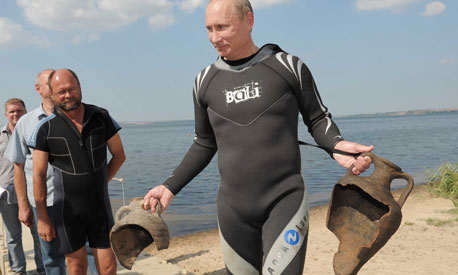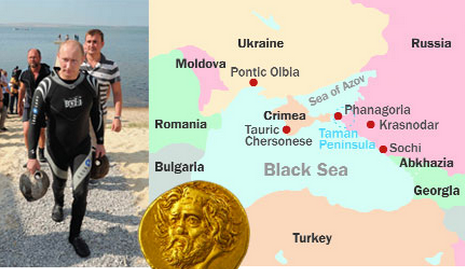Hope now that Russia will protect Crimea’s ancient sites
Apr 27th, 2014 | By Ivan Lindsay | Category: Journal

Vladimir Putin emerges form a dive at Phanagoria(the ancient Palace of Mithradates) in 2011 with 2 antique urns.
The Crimea has suffered from illegal looting of its ancient sites for years. The former Ukrainian authorities, one of the most corrupt in the world (according to the Russians and little disputed by the European Union), had little political will or financial power to control the looting. Mikahail Piotrovsky, Director of St. Petersburg’s State Hermitage Museum told the Russian Parliament in March that the Crimea Region is, “unfortunately one of the places most dear to ‘black archaeologists.'” There has been a thriving trade in ancient artifacts from the Sarmatian, Greek and Scythian periods including jewels, weapons, artifacts and armour. In recent years Russia has guarded its own nearby sites, such as Pontic Albia and Phanagoria, which were previously also heavily looted, with increasing vigilance and it is believed they will instigate similar controls now at Crimea’s ancient sites.
Shortly after the annexation, Vladimir Putin made a speech at the Kremlin where he spoke of the symbolic importance of Tauric Chersonese, a 5th century Unesco World Heritage site, where, in the 10th century, Prince Vladimir of Kiev converted to Orthodoxy. In its handling of the Crimea crisis the West, including the US, Nato, and the European Union, seem to have little understanding of the history of the region and the role that it has played in the development of Russia’s Orthodox Church. Hence, when they are puzzled by Russia’s actions, it is primarily because they do not understand the emotional background behind certain decisions which are based on Russia’s deep cultural links to the area.

Vladimir Putin in the area in 2011, a map of the area’s more important ancient sites and a gold coin (3rd Century BC), from the black sea-coast which sold in New York for US$3.25m.
For a good overview of the situation see Sophie Kishkovsky’s recent analysis in the Art Newspaper printed below :-
Sophie Kishkovsky, Art Newspaper, Issue 257, May 2014.
Russia’s annexation of Crimea, a region rich in archaeological sites that are routinely targeted by looters, has thrust illegal excavations around the shore of the Black Sea onto the political agenda. Mikhail Piotrovsky, the director of the State Hermitage Museum in St Petersburg, which has run archaeological digs in Crimea for decades, addressed the topic in a presentation to the Russian parliament in March, shortly after the peninsula voted to join Russia.
“Crimea, unfortunately, is known as one of the places most dear to ‘black archaeologists’ [those involved in the illicit searching for and trading of artefacts],” Piotrovsky said. “The level of plunder of monuments, with the help of metal detectors, is huge.” In a newspaper column just days earlier, he had written that “Crimea and Ukraine have long been on Interpol lists next to Iraq and Iran due to the pillage of treasures on their territories”. Addressing parliament, he described places in Crimea with “entire roads [where] tombs [have been] torn apart… and pillaged”.
The trade in the remains of Greek, Scythian, Sarmatian and other ancient civilisations in the regions bordering the north and east Black Sea in Crimea and South Russia can be highly lucrative. Finds, ranging from weapons to jewels, can date back centuries, even millennia. Some objects are so rare that “certain items have [never] been discovered before”, Mikhail Vlasenko, a Russian security official, told reporters when presenting items seized from looters to a museum in the Krasnodar region in southern Russia last year.
The Ukrainian media is full of stories about objects, especially coins, turning up for sale from Pontic Olbia, a former ancient Greek (and later Roman) Black Sea outpost that was founded just west of Crimea in the sixth century BC. It became a protected archaeological heritage site in the 1920s, but has been poorly protected until recently. Denis Kozak, the deputy director of Ukraine’s Institute of Archaeology in Kiev, told the Komsomolskaya Pravda newspaper in 2011 that “black archaeologists” had stolen up to 90% of the artefacts from the site.
In the light of Russia’s annexation, it is clear that some sites in Crimea will now receive attention from the Kremlin for their symbolic value. They include Tauric Chersonese, which was founded by the Greeks in the fifth century BC and is a Unesco World Heritage Site. Addressing the Kremlin on 18 March, after Crimea had voted to join Russia, President Vladimir Putin highlighted Chersonese as the place where Prince Vladimir of Kiev converted to Orthodoxy in the tenth century.
Despite the widespread pillaging, Valentina Mordvintseva, an archaeologist from the Crimean branch of the Institute of Archaeology of the Ukrainian National Academy of Sciences, says that the situation is not as bad as it was in the 1990s and early 2000s. She recalls incidents such as looters shooting at archaeologists and working with sophisticated equipment under police protection to plunder large Scythian burial mounds.
She warns that “as long as the public does not value cultural heritage, this problem won’t be eradicated. Unfortunately, no attention at all has been paid to cultural policy in Ukraine. As for the changes that might come from Crimea [joining] Russia, it’s hard to say. Problems aren’t always solved by legislation. The same corrupt law enforcement and government bodies remain in place.”
Smuggling: a “huge business”
Last year, the Russian parliament passed a law that increased fines and handed down prison sentences for illegal digging. The deputy culture minister, Grigory Ivliev, told parliamentarians that “black archaeology” had become a huge business fuelled by demand from collectors and high auction prices for antiquities. In 2012, 5,000 archaeological artefacts were handed over to Krasnodar’s Felitsyn State Historical and Archaeological Reserve, in southern Russia, near the Black Sea, after being confiscated from looters, Ivliev says.
Despite victories such as these, objects are still routinely smuggled abroad for sale. While undertaking research in Copenhagen, Valentina Mordvintseva noticed in an auction catalogue “four gold horse harness decorations in the Sarmatian animal style” that she believed must have been looted from the Krasnodar region. Two years later, while she was working at the Krasnodar archaeological museum, an identical piece was deposited there as a “chance find”. Mordvintseva says: “What amazed me was the sale in the West of pieces from plundered sites.”
The internet in Russia is full of amateur archaeology forums. On one, a member asked whether he would be able to get a metal detector into Abkhazia, the breakaway region of Georgia that borders Sochi and is recognised by only a few countries apart from Russia. Sukhumi, the capital of Abkhazia, was once the Greek colony of Dioscurius. Another forum post stated: “I don’t know what’s going on now… but a year ago, you could cross the border in an APC [the armoured personnel carriers used by the Russian military] there and back.”
The growth of illicit digging in the Black Sea region began with the collapse of the Soviet Union in 1992 and the resulting economic chaos, which coincided with the mass-market availability of metal detectors, says Vladimir Kuznetsov, an archaeologist from the Archaeological Institute of Russia’s Academy of Sciences.
For the past 40 years, Kuznetsov has been excavating at Phanagoria, once the largest Greek city on the Taman Peninsula, which runs from the Sea of Azov to the Black Sea. “What better way to earn money than [from] antiquities? The Taman Peninsula is 1,500 sq. km full of antiquities; a huge number of objects, of high-level antiquities, have ended up in Europe and America [over the past few decades]. It’s unlikely they’ll resurface now,” Kuznetsov says. “There are things that cannot have come from Italy or Greece, only from here—Scythian and Sarmatian antiquities.”
Rich pickings
Small but “fantastically rich” ancient burial mounds of local chieftains, dug up by treasure hunters in forested and mountainous areas of the region, have yielded objects such as gold helmets, rhytons (drinking vessels) and jewels. Kuznetsov says that photographs of some of these items have been shown to him by dealers who wanted to know if they were genuine and valuable.
At Phanagoria in the 1970s and 1980s, vast numbers of coins were exposed solely by rainfall. In the 1990s, these were all taken by hordes of treasure hunters, Kuznetsov says. At the time, he helped Russian television reporters film an investigation into the illicit trade. He took a hidden camera to a large market in the region, found a seller and told him that he was interested in ancient coins. The seller took him to a car with boards full of gold coins that Kuznetsov recognised as authentic antiquities from the region.
More recently, a coin from Kerch, once the ancient city of Panticapaeum in Crimea, across the strait from Phanagoria, was offered by black-market dealers around the Taman Peninsula for $15,000 to $20,000, Kuznetsov says. A similar coin was sold for $3.25m at an auction in New York several years ago, he says.
Glimmer of hope
Kuznetsov’s story has recently taken a turn for the better. Phanagoria has been adopted by Oleg Deripaska, a billionaire industrialist with roots in the region and an interest in ancient history. “Ninety-nine per cent of financing [for the work we do] is from him,” Kuznetsov says.
Phanagoria is now guarded around the clock, and Deripaska has paid for the construction of an on-site cultural and research centre, and for Kuznetsov to prepare an English translation of a richly illustrated three-volume history of the region’s archaeological heritage. Kuznetsov hopes that this will be published by Oxford University Press; he says that such publications are an important way of bridging the divide between Western and Russian archaeologists that developed in the Soviet era.
Kuznetsov’s dream is to have Phanagoria listed as a World Heritage Site and to hold an architectural competition to build a 1bn-rouble ($28m) federally financed archaeological preservation area. But for now, all government attention and finances have turned to Crimea, Kuznetsov says, so his museum project is on hold.
Phanagoria, which is partially submerged, made headlines in 2011 when Vladimir Putin, then the prime minister, dived into the sea and surfaced holding two ancient urns. Kuznetsov downplays the public mockery of that incident—it was not staged, he says, and Putin was diving at the site of a dig full of urns. More importantly, from an archaeological point of view, discarded coins were found at a site at Phanagoria that was proven to be the razed palace of Mithridates VI, King of Pontus. A tombstone found underwater, checked against Plutarch’s history of the Mithridatic wars, turned out to be that of Mithridates’s wife. It is this kind of context that needs to be preserved.
“These [treasure hunters], the amateurs, the ‘black archaeologists’—they don’t understand [that] when an amateur walks around with a metal detector, or simply with a shovel, and [destroys] the layer [of earth that preserves the history of human habitation] and takes an object out of there, he immediately deprives the object of its value,” Kuznetsov says. “Each artefact has not only an independent value, but a value connected to other artefacts that are in the same layer [of earth].” Plucked out of context, Kuznetsov says, it might have some aesthetic value, “but no historical value”.
